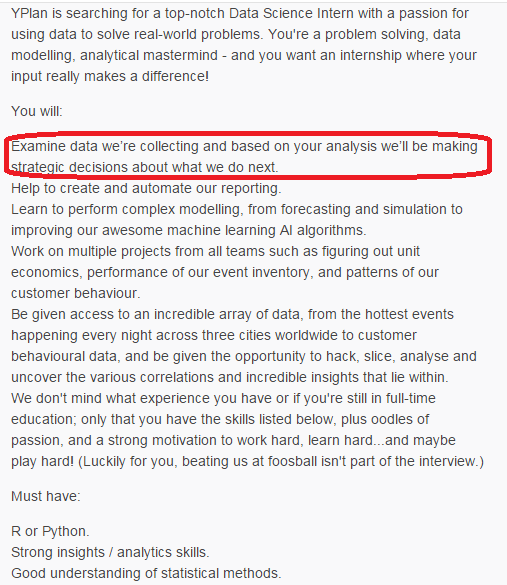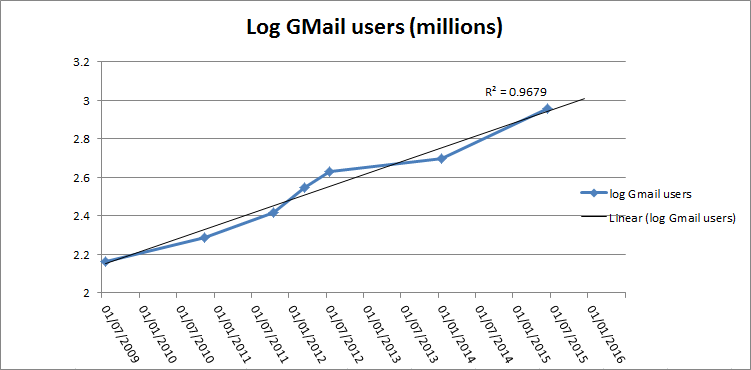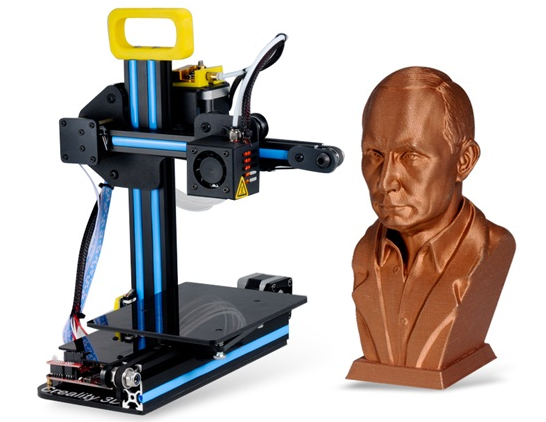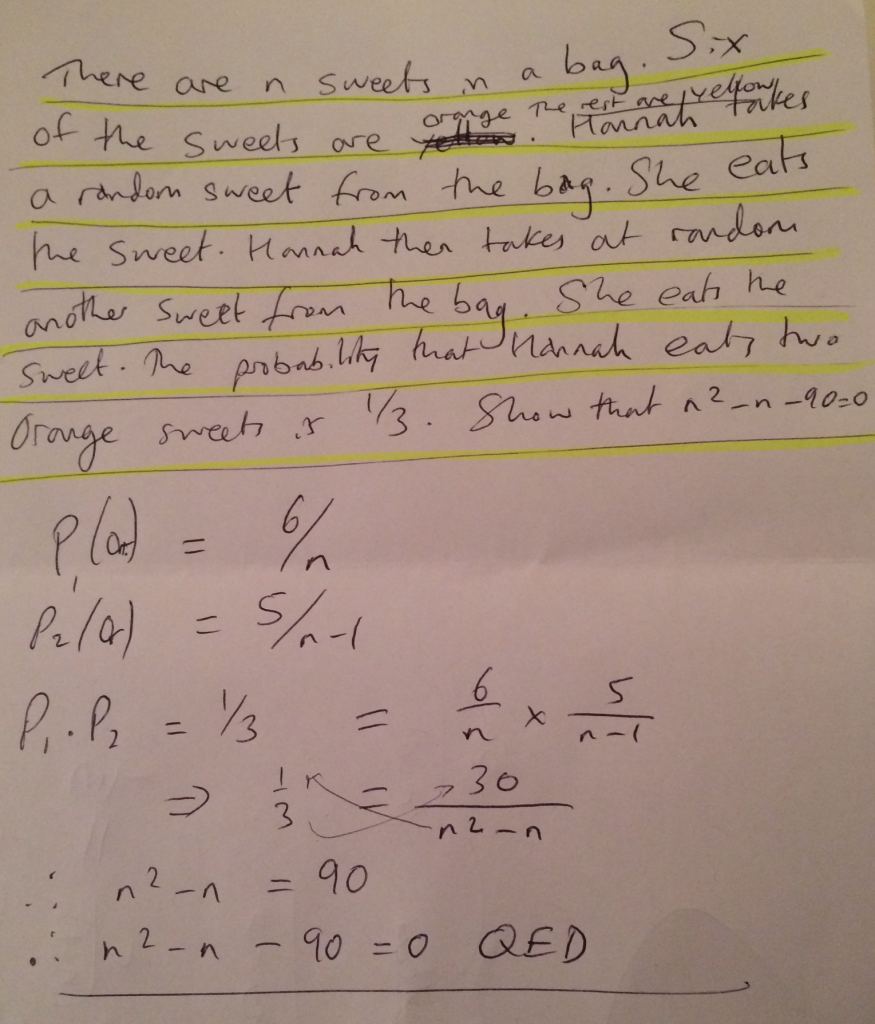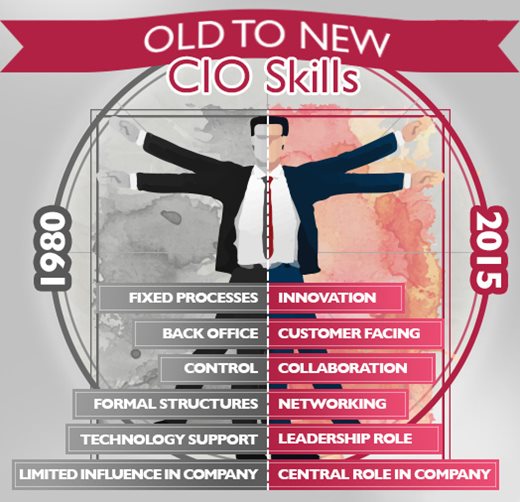Sections
- Digital Enterprise
- Devices and Manufacturers
- Google and Android
- Apps and Services
- Data Science and Visualisation
- Robots and Artificial Intelligence
- Wearables and the Internet of Things
- Hardware and 3D Printing
- Fun, Games and GCSEs
- Software Engineering
- Agile, DevOps and Cloud Computing
- Innovation
- Big Companies and Corporate Strategy
- Startups
Digital Enterprise
[avatar user=”malm” size=”small” align=”left” link=”file” /]
Carlo Gagliardi heads up PriceWaterhouseCoopers’ (pwc) Strategy for the Digital Age offering. The advice that he provides to major corporate clients is built around the fact that advancing technology is driving massive change across every industry and to survive let alone prosper businesses need to dramatically change the way they are structured and operate. In particular, embracing digital technology should not be delegated to another silo in the org chart – it needs to infuse the very core of corporate strategy:
In this digital age you don’t need a digital strategy. You need a business strategy for the digital age.
Amongst the behavioural changes that ensue from this pivot are the championing business agility, innovation and failure in a world in beta. Perhaps the biggest challenge in making that shift lies in the constitution of the typical corporate Board and Management Team today. Despite advances, these structures remain unrepresentative of the diversity of wider society. In many cases they are still dominated by older white males lacking an instinctive feel for digital technology. Real behavioural change such as the strategic promotion of youthful “digital natives” can be a serious challenge in such a context. The new breed of business leaders who get this don’t tend to be in a large company – they’re in startups and already realise exactly what this entails:
Traditional management functions even when they recognise something must be done tends to tread around the edges and set up innovation processes or cross-functional committees in an attempt to move forwards. Whether it is possible to succeed or not ultimately does not depend on processes or policies but on culture which is built on principles and values. Those are very hard to remould once established:
“Companies that are truly innovative are not necessarily consciously doing things to “be innovative.” Rather, they value at their core, certain things that drive innovative behavior and the result is innovation.
It’s really a culture issue- something that resides in the deep recesses of the collective subconscious that guides people by saying, “Hey, these behaviors that are usually associated with innovation- those are really good behaviors in this organization and we really value them.”

Failure to examine the iceberg of principles and values accounts for the subsequent failure of many corporate improvement initiatives. There is no substitute for investing time and effort in understanding what is going to work in context:
Don’t just jump on the next bandwagon, whatever that might be. Learn thoroughly about a new approach before you roll it out deeply and widely in your organization. Run small-scale experiments to get first-hand experience. Understand the organizational culture. Evolve the approach so it better fits your context.
It is possible for big companies to change culture but it’s far easier if they were grown organically from the outset by visionary leadership. Tesla is a great example. Their ambition is nothing less than changing the model of the global automotive industry with autonomous electric vehicles, a world notoriously replete with vested interests and conservatism. Tim Urban in an epic WaitButWhy post (even by his prodigious standards) explains why the Tesla S will change the world but also why disruption can take a hard toll on the disrupters too. And in Tesla’s case continues to do so with many analysts like Asymco still somewhat skeptical about Elon Musk’s strategy. Imagine how much harder it must be fighting to do this kind of thing on the inside of a big company:
“if a more advanced future does happen, it’s because that future was willed into our lives by a few brave people. The present isn’t welcoming of an advanced future because the present is run by a thick canopy made up of the ideas, norms, and technologies of the past. There’ll be incremental tweaks and slight iterations on proven-to-work concepts, which may seem to us like moving into the future, but it’s really just a polishing up of the past.”

Devices and Manufacturers
- Anyone still harbouring hopes for Tizen as a viable platform contender should read this excoriating analysis of the Enlightenment Foundation Libraries (EFL) that constitute the UI framework for the platform. Written by someone who clearly resents having to use EFL professionally, the platform seems worse on every count in comparison with Qt and its UI markup language QML. It’s a great illustration of why building a compelling user platform is really hard. The article is somewhat agricultural in tone but if it reflects wider developer sentiment, EFL looks destined to be yet another evolutionary dead end for Linux UI technology. And Tizen’s future could already be all used up:
“Some of you may know a Qt presentation, where someone built a fully functional media player with theme support in QML in real-time in front of an audience. Doing the same in EFL is measured in man-years. I’m pretty serious about that one. Small projects like these require teams of 5-10 programmers working up to a year.
And did I mention EFL is the basis of all applications on Tizen?”
- HTC’s CEO Cher Wang has apologized for poor company performance attributing it to “poor operational efficiency and overly conservative marketing strategy amid fierce competition in the global market.”
“Slow sales of the One M9 have been widely attributed to the phone’s identical design to its predecessor, the One M8. It doesn’t help that rumors spread during its first few weeks on the market that the processor it uses, the Snapdragon 810, has overheating issues.”
Google and Android
- Google IO in depth review of what’s new in M:
- This up close review of Google Now on Tap, announced at Google IO, suggests it will become “the glue that holds Android together” and profoundly affect the experience of using Android M based products onwards. Now on Tap will add Google Search smarts to every application on device and force Android developers to consider adding contextual support to their apps in the form of app indexing and markup to take advantage of it:
“In essence, Google Now on Tap takes the power of Google Now and makes it a core part of the Android operating system. Instead of just being a standalone app that you open sometimes — and maybe see in your notifications once in a while — Now on Tap turns Google Now into a connective tissue that ties everything on your device together with potent Google intelligence.”
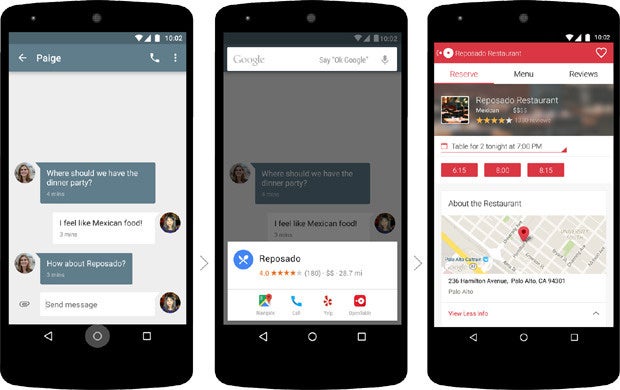
- App Invites is another Google-specific feature that could have a major impact on future Android user experience. It is essentially a personalised Android app discovery service which can recommend Google Play apps to specific contacts as well as preferred delivery methods for any corresponding invites. The intent being to help Android developers drive app install base using deep linking from within their own applications. A clear side-effect, however, being greater Google service lock-in:
The invites can be sent out over SMS or emails which include an “install” button right in the body of the message. On Android, the install process is even easier – users click on “App Invite” and can immediately download the app from the Google Play store without first being taken to a web browser in between.

- Project Vault was an announcement from Google IO that didn’t get an explicit mention in last week’s Google IO write up. Vault is noteworthy, however, as an interesting attempt to tackle the usability and security issues associated with passwords. The project has come out of Google ATAP and has distinct moonshot qualities particularly in relation to the ambition of its embodiment:
“a secure device that plugs into any system both desktop or mobile that supports microSD. The device runs its own ultra-secure operating system that’s partitioned from the rest of the host device with 4GB of storage for your most sensitive data. … Google wants it to be as user friendly as possible so the host does all the work without the users having to deal with configuring the device.

- This GMail tweet confirms that the service is well on it’s way to a billion users in the near future:
Gmail now has over 900M users! Thanks for helping us get here. pic.twitter.com/pvz1r4WVJP
— Gmail (@gmail) May 28, 2015
- There is remarkably little publicly available info on its user base but one can reconstruct GMail’s growth trajectory from resources such as this Quora post. Doing so reveals an exponential that intersects with a billion users sometime over the next few months before the end of this year.
- Project Ara just reached a notable milestone with the first public demo of a photograph being taken from a plug-in camera module. The picture quality could do with some post-processing TLC courtesy of Google Photos but even so, this is a very impressive mark of progress and statement of intent. Expect further developments soon given the observation from TechCrunch that the Ara phone use for the demo:
“[was] a version that looked much more like a shipping consumer prototype than developer hardware.”
First public photo from our ARA phone at #io15. Next app install will be @googlephotos to fix lighting. #ProjectAra pic.twitter.com/EvFCQbbHo8
— Project Ara (@ProjectAra) May 29, 2015
Apps and Services
- Snapchat has over 100 million mostly young active users, a valuation of over $15billion and 330 employees but no clear business plan. Bloomberg’s interview with 24-year old CEO Evan Spiegel suggests that might be about to change with video brand advertising:
After starting to run select video ads earlier this year, Snapchat is about to begin soliciting other big advertisers with some new numbers that assert its audience is bigger, younger, and more obsessive than anything on television. In a 23-page sales pitch it’s sending to ad agencies this month, the company says more than 60 percent of 13- to 34-year-old smartphone users in the U.S. are active on the service and together view more than 2 billion videos a day.
- Asian eCommerce leader Coupang has received investment from SoftBank valuing it at $5billion. The company is often referred to as Korea’s Amazon:

- Pie is a simplified workplace chat app that has just raised $1.2million Series A funding for a cross-platform “Slack lite” proposition:

- Back in the day when “mash-ups” were the thing, Yahoo Pipes was seen as a cool and exciting enabler technology for joining different service propositions together. Tim O’Reilly went as far as to call it “a milestone in the history of the internet” at launch. Unfortunately it never made any real headway ranged against GAFA platform ecosystem interests. Yahoo are now shutting it down. TNW reflected on Pipes’ closure:
Pipes was a little too complicated for most users, a curious wonky solution to problems that the majority of people don’t even think about very much. But it represented an important philosophy – the idea that the Web is about connecting, not building walled gardens.
- LastPass is one of the best password manager propositions around and its Security Challenge feature is a revelation. It just got even better:
With our redesigned Security Challenge, we’re helping you create stronger passwords and improve your security, faster than ever before. The LastPass Security Challenge now gives you an audit of your passwords that is more intelligent and actionable, with known breaches prioritized.

Data Science and Visualisation
- Plotly have published a blog post which showcases seven modern remakes of “the most famous graphs ever made” according to Edward Tufte’s classic The Visual Display of Quantitative Information. One of the seven is Tufte’s highlight, Minard’s graph of Napoleon’s March to Moscow:
- This NYT post highlights a US survey that points to rising resistance among American consumers to the data mining practices of providers of online services. However it also suggests a degree of resignation on what they are able to do about it.
“Among people who took part in the survey, 84 percent strongly or somewhat agreed that they wanted to have control over what marketers could learn about them; at the same time, 65 percent agreed that they had come to accept that they had little control over it.
- One analyst quoted in the piece suggests consumers’ experience with progressively more sophisticated data-mining systems is an example of “boiling frog” syndrome. It’s hard to disagree when you consider what global social media propositions like Facebook and Instagram are already mining from our smartphones today. If you’re concerned enough to change, you need to check your location and privacy settings.
- No wonder data scientists are among the most sought after talent right across the board. Here’s another post on how to hire data scientists which focusses on “the challenge”:
Set up a challenge to learn how the candidate works in the wild. For example, we’ve done challenges asking candidates to predict how many people can survive the Titanic. … Candidates should create a daily project plan that presents a glimpse of how their brain works – algorithms to predict survival rate, what age and gender are more likely to survive than others and why and other factors you would have never even thought of.
Robots and Artificial Intelligence
- RoboSimian is NASA JPL’s entry for the DARPA Robotic Challenge and one of the few non-biped entries. Crazy Engineering ran a short preview of what the robot, who is designed to deal with disaster response scenarios, can do:
- MIT’s Cheetah robot can now jump over obstacles as well as run. This alternative ‘best in show’ video is well worth watching – it dramatically underlines recent advances in state of art both robot vision and limb robotics. What you see here was inconceivable as little as five years ago:
- Also from MIT, a tiny magical foldable ‘origami drone’ that can “walk and swim” using magnets:
- Automation dystopian and Glass Cage author Nicholas Carr asks whether computers can improvise after being taken to task for claiming in a recent NYT op-ed that they were terrible at doing so and would “always need humans”. Amongst the evidence ranged against him were the thin claims of DeepBeat, an AI that “produces rap lyrics that rival human-generated rhymes“. Cue this example dismissed as “witless” by Carr which is unlikely to give Eminen cause for concern:
Girl I’m down for whatever cause my love is true
This one goes to my man old dirty one love we be swigging brew
My brother I love you Be encouraged man And just know
When you done let me know cause my love make you be like WHOA
- The more serious question for Carr, however, is whether we are on an ‘inevitable’ escalator to ASI. He suggests that the real barrier for the ANI -> AGI transition will be in understanding and developing artificial ‘common sense’ and that rather than an exponential we may just be on a sigmoid facing a new “AI winter” when we find that machine learning can only advance AI so far:
Since we don’t know how the minds of human beings and other animals develop common sense, or gain self-awareness, or learn to improvise in novel situations, we have no template to follow in designing machines with such abilities. We’re working in the dark.

- It’s a sentiment that would no doubt be echoed by Douglas Hofstadter the “forgotten man” of AI and celebrated author of Gödel, Escher, Bach (“GEB”) released 35 years ago. This long, fascinating Atlantic profile piece from a couple of years ago outlines Hofstadter’s views. For him the current primacy of RNN-driven machine learning as a practical tool for driving AI success stories masks the fact that we are still no closer to a real understanding of how human intelligence works. It’s akin to attempting to claim special knowledge of the flight of birds with an aeroplane analogy:
It seems unlikely that feeding Google Translate 1 trillion documents, instead of 10 billion, will suddenly enable it to work at the level of a human translator. The same goes for search, or image recognition, or question-answering, or planning or reading or writing or design, or any other problem for which you would rather have a human’s intelligence than a machine’s.
Wearables and the Internet of Things
- IDC data suggests the wearables market tripled in size year on year in Q1 2015:
“New data from analyst firm IDC reveals the wearable device market, which includes fitness bands and smart watches, increased by 200% year-on-year in Q1 2015 to hit 11.4 million units shipped.”
- Fitbit and Xiaomi together constitute nearly 60% of market share though it should be noted this data is pre Apple Watch launch:
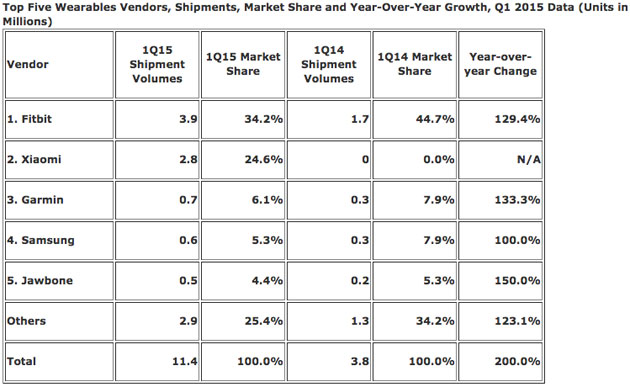
- Jawbone are in the top 5 wearable OEMs but have been struggling with the much delayed Jawbone 3. You can however at least buy a Jawbone 2 now in the UK for £90.
- It’s still relatively early days to gauge the long-term prospects of Apple’s pivot to luxury with the Gold Edition Apple Watch. One rather enterprising Kickstarter proposition naturally called Midas Touch is offering a $100 kit to use electrochemistry to gold plate your steel Apple Watch.
“Unlike the posers who have just painted the watch gold, this process actually chemically binds 24 karat gold to the stainless steel surface. The kit currently requires a stainless steel Apple Watch, but a new process to coat the Sport is in the works.”
- Midas Touch has generated a fair amount of interest on Kickstarter. Apple presumably aren’t overjoyed with the premise and motivation of its creator Eric Knoll, though:
Don’t get me wrong – I love Apple products, such as my iPhone. However, the $10,000 Apple Watch Edition is absurdly expensive and disproportionately priced just for the sake of creating a high-end luxury item.

- The Sony SmartBand was relatively well received when it launched. It appears that a v2 is on its way with integrated optical heart rate monitor courtesy of an updated companion app spotted in the App Store.

- The Kisai Link is another interesting addition to the smart band landscape. It is specifically aimed at fashion-conscious youth and apparently “eschews all nerdiness”:
- The Register takes a characteristically irreverent look at health trackers and ponders whether they really do help keep you in shape, assuming you are sufficiently motivated to wear them.
- Thync who have been highlighted in the blog in the past for their work on transcranial direct current stimulation (or tDCS) have launched a mood changer wearable in the form of a triangular plastic neurosignalling device. It will retail at around $300. TechCrunch went hands on and found it a weird experience.

- This thought-provoking VisionMobile post co-authored by Andreas Constantinou outlines the huge potential for IoT to extend to the “eCommerce of things” by offering a literally physical embodiment of a call to action. IoT OEMs and white goods manufacturers that fail to act on the opportunity could be disrupted out of existence. Amazon’s Dash is a clear sign of things to come:
The IoT extends e-Commerce affiliate and user acquisition schemes beyond websites, mobile and apps, into every physical object … [and] will allow e-Commerce to stretch across the breadth of the customer journey
Hardware and 3D Printing
- Good OReilly post on why the IoT is not the same thing as the new ‘cheap hardware’ movement. The former is driven by ubiquitous connectivity, inexpensive data, access to machine learning and of course cheap hardware. The latter is more specifically focussed on ecosystems and tools for a range of activities:
- Prototyping (inexpensive 3D printers, CNC machine tools, cheap and powerful microcontrollers, high-level programming languages on embedded systems)
- Fundraising and business development (Highway1, Lab IX)
- Manufacturing (PCH, Seeed)
- Marketing (Etsy, Quirky)
- Here’s an interesting data point. You can now buy a high performance 3D printer for $230.
- Electroloom have a Kickstarter for building a “3D Printer for fabric“. It works by “spraying a solution containing a polyester/cotton blend on a template to create clothing without seams“.
- In a curious reverse echo, the PixelWeaver is a mechanical display inspired by the Jacquard loom that powered the first industrial revolution:
it’s a 32-hook Jacquard style punch card reader that could be mounted over a small loom. Instead of weaving rugs and fabric, the PixelWeaver controls a 6×5 black and white display.
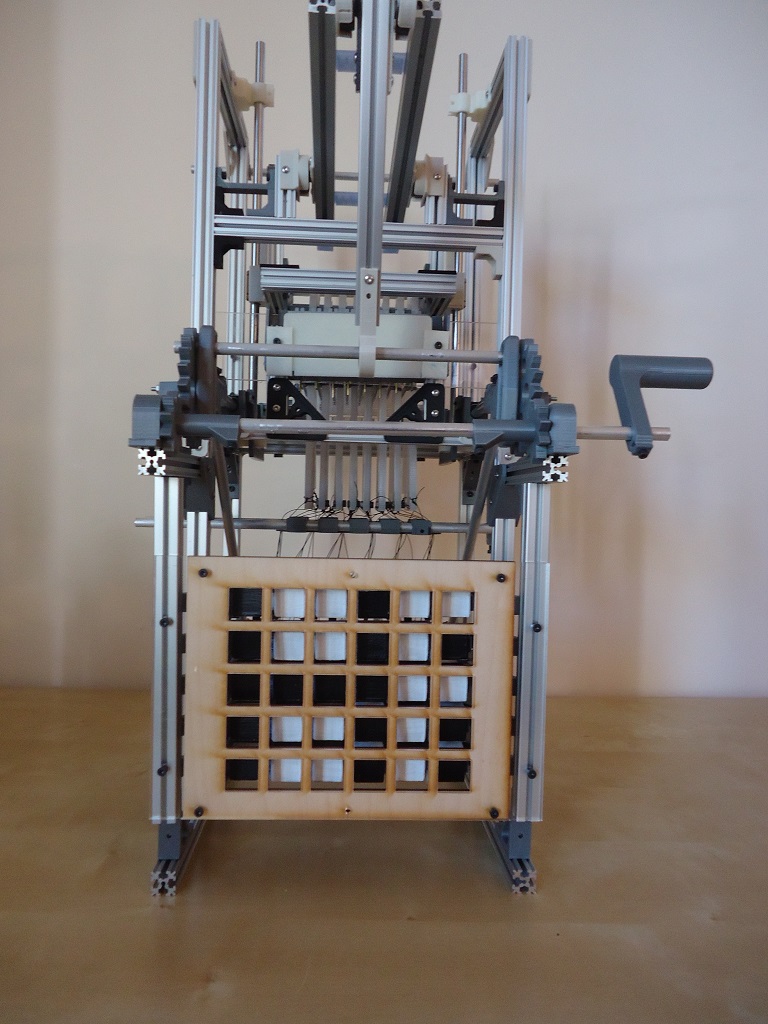
- Hot swappable Raspberry Pi rack “inspired” by Enterprise blade servers.

Fun, Games and GCSEs
- TechCrunch are very impressed by ShapeKit, a fun educational iPad app that “draws inspiration from early 20th century design and stop-motion animation to make learning shapes and colors fun.” The colour palette was apparently inspired by Bauhaus and Paul Klee.
- Lego has finally built a direct competitor to Minecraft. Labelled Lego Worlds, the game has been launched as an early beta on Windows and features a close tie-in with real world plastic Lego brick kits.

- This week a difficult maths GCSE question about “Hannah’s sweets” seemed to get an awful lot of students and parents exercised. It’s hard to understand why it should have been so vilified. Conditional probabilities and probability trees do appear to be legitimate topics for GCSE examination so it seems like a straightforward question on an important subject that leads on to topics like Bayes’ Theorem. We’re in danger of lowering the UK bar to such an extent that the country (already sliding down the international numeracy scales) simply isn’t competitive at STEM on the global stage. Sounds like we need Count Baysie to ride to the rescue with another lego probability space analogy. Here’s a solution sketched out in a minute on the back of some scrap paper on first encountering the question.
Software Engineering
/** * For the brave souls who get this far: You are the chosen ones, * the valiant knights of programming who toil away, without rest, * fixing our most awful code. To you, true saviors, kings of men, * I say this: never gonna give you up, never gonna let you down, * never gonna run around and desert you. Never gonna make you cry, * never gonna say goodbye. Never gonna tell a lie and hurt you. */
- Sebastian Thrun as well as being the driving force behind Google’s autonomous vehicle project is a co-founder of MOOC player Udacity. His personal moonshot is the democratisation of education which is clearly a real passion for Thrun. He hopes to achieve it through the proliferation of nanodegrees:
Where nanodegrees part with existing education is execution. You pay $200 per month, and learn at your leisure. There are no semesters, attendance requirements, or frat house keggers. It’s pulp learning — with a degree waiting at the end — and Thrun thinks that is exactly what the world needs.

Agile, DevOps and Cloud Computing
- Skype’s Head of Agile Transformation outlines its use across 150 engineering teams across the company. At that scale consistency and clear communication of the overarching estate becomes more important than whether or not individual teams are using Scrum or Kanban:
“We very quickly came back to … the portfolio planning process and how do we get the organization to align around something consistent, and the theory of constraints came out as the thing that was the simplest to understand that would drive those principle conversations.”
- Useful technical post from MindCandy on how to best take advantage of AWS spot instances to reduce your cloud bill.
- Quartz suggest we’re now well beyond debating the pros and cons of cloud. If you’re not already using or planning to use cloud services, you face being in a dwindling minority within a couple of years:
By 2018, more than 60% of enterprises will have at least half of their infrastructure on cloud-based platforms (PDF), but it’s no longer about the infrastructure but about what that infrastructure enables.
- This post provides an insightful Enterprise CIO perspective on why the future is not just about cloud but open source software (OSS) as well. In addition to the expected OSS references to greater transparency, greater influence and greater innovation potential, the author suggests the biggest reason for the ultimate triumph of open source is business model alignment with the variable demands of so-called Third Platform architectures and in particular the container model (cf. Docker):
“open source licensing models are a much better fit for Third Platform applications. Their inherent load variability means that new instances/containers are being started and stopped all the time. This presents an enormous challenge to proprietary code products, as they are typically licensed on a perpetual basis per instance/container. If an application has extremely high use over 10 percent of its lifespan, that means buying a lot of licenses that are rarely used. Proprietary licenses are a good fit for static applications with stable use profiles. “
- In a major endorsement for Google, the UK HMRC, arguably the most powerful government division, has switched from Microsoft to Google for its cloud service provision:
More than 70,000 employees will make the switch, joining 2,500 Cabinet Office users already on Gmail.
- In spite of the hype, Martin Fowler, widely seen as the father of microservices, reckons you might better off without them if you can’t afford to pay the Microservices Premium. Specifically he reckons you might be better off starting with a “monolith-first” strategy before attempting to break down:
“Microservices are a useful architecture, but even their advocates say that using them incurs a significant Microservice Premium, which means they are only useful with more complex systems. This premium, essentially the cost of managing a suite of services, will slow down a team, favoring a monolith for simpler applications. This leads to a powerful argument for a monolith-first strategy, where you should build a new application as a monolith initially, even if you think it’s likely that it will benefit from a microservices architecture later on.”
- No wonder it’s confusing and complicated being a CIO these days. However, it’s an increasingly pivotal role at the forefront of business transformation for the digital age regardless of vertical. The nature of the role has changed utterly in the last 20 years as outlined in this article:
Innovation
- This post on the global innovation suggests something of a mixed bag with the overall level of unique inventions now over 2 million a year but slowing year-on-year growth. It also highlights a clear trend towards externally focussed “open innovation”. That is a key characteristic of an modern organisation seeking to transform itself for the digital age as discussed earlier.

Across virtually every industry studied, the trend toward “open innovation,” whereby companies partner with academic institutions, individual researchers and other companies (in some cases, even competitors) has been on visible display. The ability to cull ideas from inside and outside one’s company has granted some firms a refreshing new way of thinking, as they have opened up their patents to a set of fresh eyes in order to gain new insights.
Big Companies and Corporate Strategy
- McKinsey published an article earlier this year outlining how vital growth (and exponential growth at that) is for a modern software and services business. The revenue funnel is daunting:
“Even if a software company is growing at 60 percent annually, its chances of becoming a multibillion-dollar giant are no better than a coin flip.”
- In the face of such extremity of outcome, it’s important for incumbents to absorb the lesson that even a relatively successful business model is no guarantee of future success. Steven Sinofsky alludes to it in this post in which he essentially suggests that companies that wish to avoid disruption need to skate to where the puck is going to be not where it already is. And that “all the parts move” meaning that just because a new entrant only does some of the things you do, that doesn’t mean they can’t disrupt the rest in due course. He explicitly calls out Blackberry but this could apply to Nokia and many others:
Once a new platform gains momentum and you start losing your partners or can no longer attract the top talent to the platform you have seen the warning sign and so has everyone else.
- HBR article on the “death grip” that legacy technologies impose on large companies. It’s another important factor in encouraging such organisations to continue to exploit the status quo and quell attempts to explore disruptive internal innovations. A key cultural question is the degree to which the business is able to route around the sunk cost fallacy:
“previous investments that have not been fully depreciated can get in the way of new investments. And once investments are fully depreciated, they have a habit of hanging on by virtue of marginal costing.
- This analysis of Nokia’s business strategy in relation to manufacturing from the Centre for Research on Multinational Corporations is in equal measure informative and utterly depressing. Sadly, however, one has to say its findings are not really that surprising in the context of globalisation – multinationals are expected to maximise profit and minimize costs. The report outlines how Nokia during its peak and indeed through its disastrous and chaotic decline consistently sought to shift manufacturing to lowest cost locations seemingly without regard for the social impact. It goes on to detail the incalculable havoc and misery the approach inflicted for many of its workers particularly in China, Mexico and India:
“The report illustrates how workers at Nokia’s manufacturing sites and its supplier companies were systematically unable to benefit from the company’s success, while facing the most difficult consequences of the company’s decline.”
Startups
- To keep your startup real and help it succeed you need to bring sales into the Leadership team.
- Fascinating TechCrunch insight into language diversity within startups across the globe shows that the US is top of the table by far. It matters hugely in terms of international ambitions particularly in relation to content localisation:
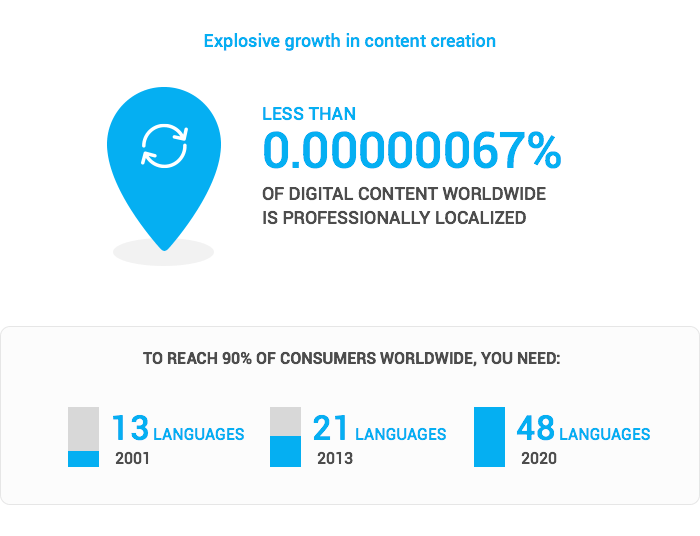
- According to Bill Gross startups are “one of the greatest forms for making the world a better place“. If that’s the case, why do so many fail? Gross outlines his systematic analysis of hundreds of companies in the TED Talk below. Ideas, Team, Business Model, Funding and Timing are all considered. The number one factor at 42% is Timing. Then 32% is Team and Execution. Get those two right and you improve your chances. The others are all subject to pivot. Or as Gross puts it courtesy of Mike Tyson:
“Everybody has a plan until they get punched in the face”
